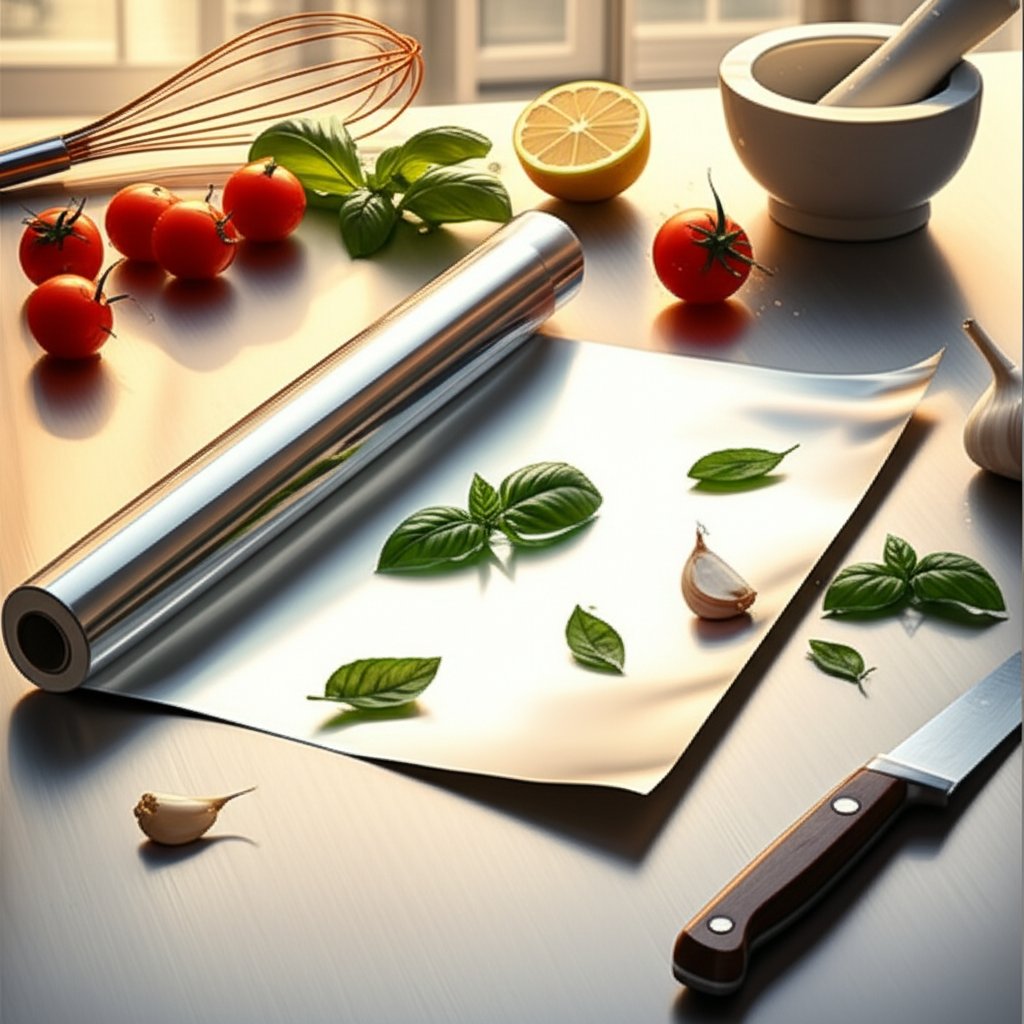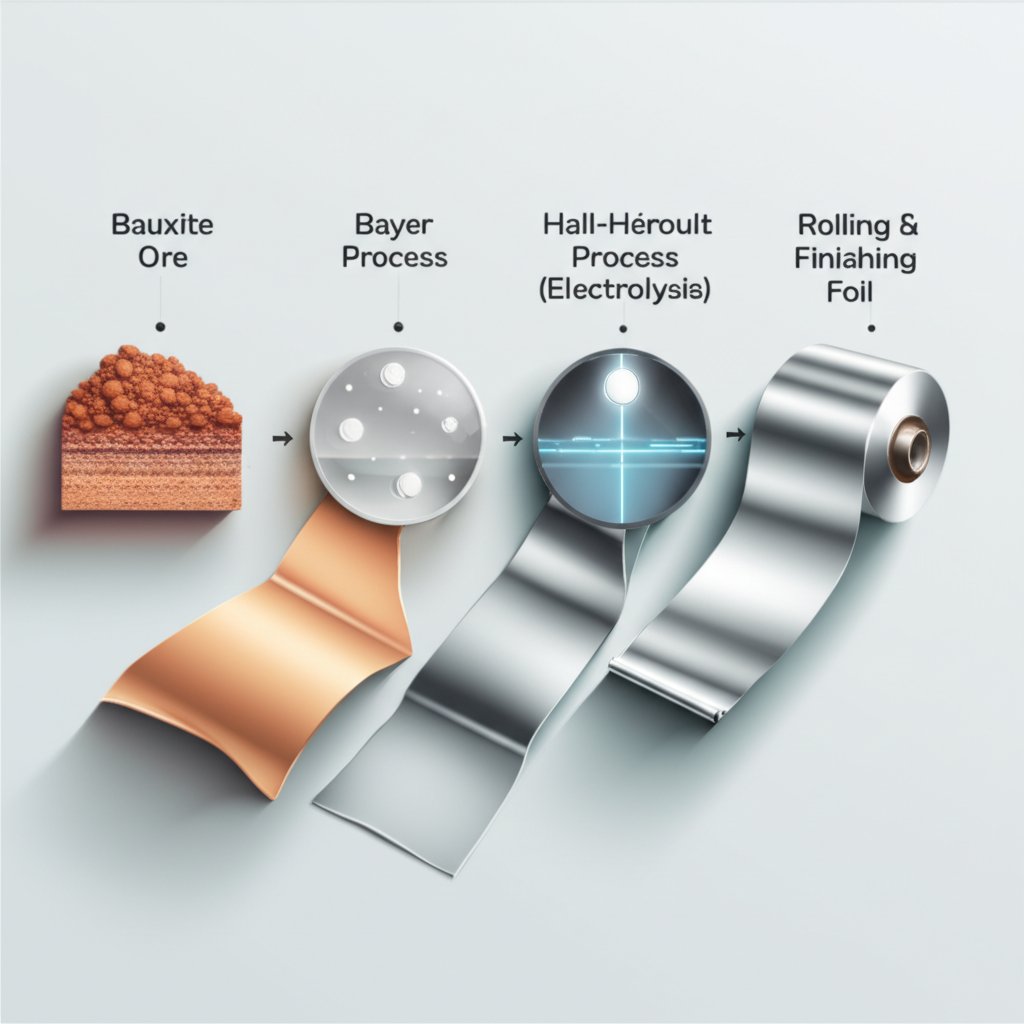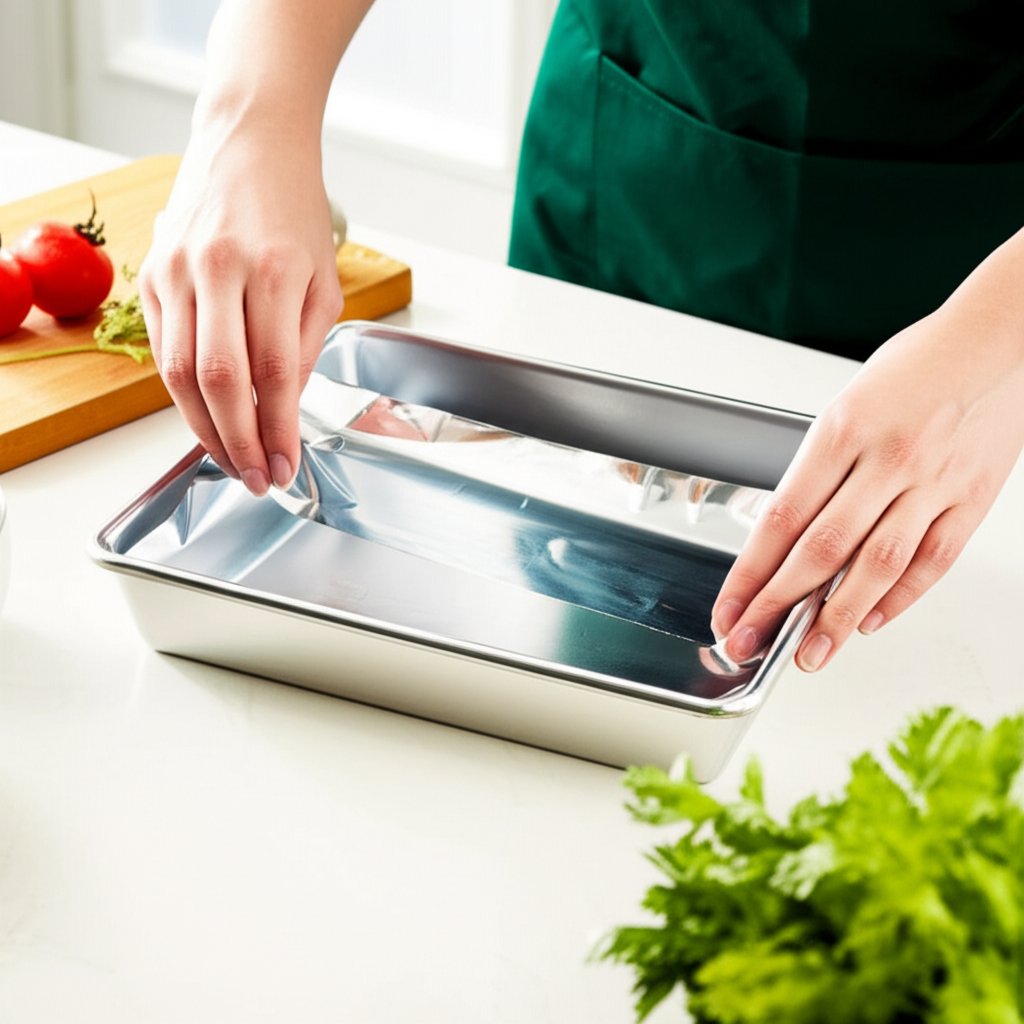
Open almost any kitchen drawer and you’ll find a familiar roll of shiny, flexible metal—what most of us call aluminum foil. But have you ever wondered, what is aluminum foil really, and how did it become such a staple in our homes?
Today’s kitchen foil is actually made from aluminum, not tin—despite the common habit of calling it "tin foil." This confusion dates back to the late 19th and early 20th centuries, when real tin foil was the standard for wrapping food and even used for early audio recordings and dental fillings. Tin foil was less malleable and sometimes left a metallic taste behind, which led to the search for a better alternative.
Did you know? The first commercial aluminum foil rolling plant opened in Switzerland in 1910, and by 1911, iconic brands like Toblerone were already using it to wrap chocolate bars. This marked the start of aluminum foil’s rise to global kitchen fame. [Source]
So, when was tin foil invented? Tin foil dates back to the late 18th century, but it was phased out after World War II when aluminum became more affordable and widely available. If you’re wondering, can you still buy tin foil? The answer is: not really. While you might find specialty "foil paper" made from tin for niche uses, nearly all "kitchen foil" sold today is made from aluminum due to its superior properties and lower cost.
Aluminum foil—sometimes labeled as aluminium aluminium foil in other countries—is a thin sheet of pure aluminum, typically less than 0.2 mm thick. It’s prized for its flexibility, ability to form a tight seal, and resistance to light, moisture, and odors. Whether you use it for roasting, baking, or storing leftovers, this everyday product is the result of over a century of innovation and material science.
In the next section, we’ll explore how this seemingly simple kitchen staple is made and what makes it so uniquely suited for modern cooking.

Ever wondered how a roll of kitchen foil transforms from raw earth to the gleaming sheet in your drawer? The journey of aluminum foil material is a fascinating blend of geology, chemistry, and precision engineering. Let’s break down how aluminum foil is made and why its properties make it so indispensable in the kitchen and beyond.
The story begins with bauxite, a reddish ore found close to the earth’s surface. Mining bauxite is straightforward—after removing the topsoil, large machines extract the ore, which is then transported to processing plants. Here’s what happens next:
Curious about how to find the thickness of aluminum foil? Manufacturers use precise measurements, often weighing a sample and dividing by its area and the known density of aluminum. Standard household foil typically measures around 0.016 mm thick, while heavy-duty versions are closer to 0.024 mm.
So, what is aluminum foil made of, and why is it so versatile? The answer lies in its unique combination of properties:
And if you’re curious about the aluminium foil melting point, it’s around 660°C (1220°F), far above any typical cooking temperature.
Thanks to these properties, foil isn’t just for wrapping leftovers. It’s used for packaging, insulation, electronics, and even in the medical field. Understanding the science behind this everyday material helps explain why it’s so trusted in kitchens worldwide.
Next, we’ll tackle the crucial question: does aluminum foil leach into food, and is it truly safe for cooking?
When you pull out a sheet of shiny foil for roasting veggies or wrapping leftovers, you might wonder: is cooking with aluminum foil safe? With so many rumors online about aluminum foil toxicity, it’s easy to feel uncertain. Let’s break down the science, clear up common myths, and help you make informed choices in your kitchen.
First, it’s important to know that aluminum is naturally present in the environment and, as a result, in many foods—even before they touch any foil. Everyday dietary exposure to aluminum comes mostly from food, water, and certain food additives. But does aluminum foil leach into food while cooking? The answer is: yes, but the amount depends on several factors.
Scientific studies confirm that the amount of aluminum released from foil is generally low, but can be higher in these specific conditions. For example, a study found that meat and fish cooked in aluminum foil had increased aluminum content, especially when seasoned with salt or lemon juice and baked at high heat (see full study).
Is aluminum foil toxic? The short answer is: for most healthy adults, typical use is considered safe. Your body is equipped to handle and excrete small amounts of aluminum absorbed from food. According to the Centers for Disease Control (CDC) and the European Food Safety Authority (EFSA), only a tiny fraction of ingested aluminum is absorbed, and most is quickly eliminated through urine or feces (Food Network).
"A very small amount of the aluminum in food or water will enter your body through the digestive tract. However, most aluminum in food, water and medicines leaves your body quickly in your feces. Small amounts of aluminum can also enter your bloodstream but will leave your body quickly through the urine." — Centers for Disease Control (CDC)
Despite persistent rumors linking aluminum to Alzheimer’s disease or other serious health conditions, current research has not found a direct link between normal dietary aluminum intake and these illnesses (Healthline). The World Health Organization and EFSA have set a tolerable weekly intake (TWI) of 1 mg of aluminum per kg of body weight. Most people’s exposure, even with regular foil use, remains well below this threshold.
Still, some people may want to take extra care. Children, who eat more relative to their body weight, and individuals with kidney problems (who have trouble excreting metals) may be more sensitive to aluminum intake. If you’re concerned, avoid wrapping acidic or salty foods directly in foil, especially for long cooking times or high temperatures. Opt for glass or ceramic containers for storage, and use parchment paper as a barrier for high-acid dishes.
So, is aluminum foil bad for you? For most home cooks, the answer is no—especially when used thoughtfully. In the next section, we’ll share practical tips and best practices to help you get the most from your foil while minimizing any potential risks.

Ever wondered if you’re getting the most from that roll of foil in your kitchen drawer? Whether you’re roasting, baking, or grilling in aluminum foil, mastering a few simple techniques can make cooking easier, cleaner, and even tastier. Let’s break down the best ways to use oven aluminium foil—plus some clever hacks you’ll wish you knew sooner.
When you’re deciding how to use aluminum foil, think beyond just covering a casserole. This kitchen staple is a true multitasker, but it’s important to use it correctly for each task. For example, are you supposed to put foil on the grill? Absolutely—but with a few smart precautions. Lining grill grates with foil can simplify cleanup and keep smaller foods from falling through, but always poke a few holes to let heat circulate and prevent flare-ups. When baking, a foil sling can help you lift delicate cakes or brownies out of the pan without breaking. And if you want to avoid sticking, Reynolds Wrap non stick aluminum foil is a game-changer, especially for cheesy or sticky foods.
When using foil on the grill or in the oven, always follow manufacturer guidelines and avoid covering oven floors directly, as this can interfere with heat circulation. For sticky foods, try Reynolds Wrap non stick aluminum foil—just remember, the dull side is the nonstick side! And for more creative ways to use foil, including air fryer safety and best practices, check out this in-depth guide on air fryer foil use.
By combining these simple hacks with a few safety precautions, you’ll get the most from every sheet—whether you’re baking, roasting, or grilling in aluminum foil. Next, let’s explore some surprising uses for foil outside the kitchen that can save you time and effort all around the house.
When you think of aluminum foil uses, your mind probably jumps straight to food storage or lining baking sheets. But did you know this humble roll can tackle dozens of everyday challenges around your home and garden? Imagine sharpening dull scissors, protecting your garden from pests, or even giving your radiator a boost—all with a single sheet of foil. Let’s explore just how versatile this so-called paper foil paper can be when you start using aluminum foil beyond the kitchen.
Why limit foil to leftovers when it can help you clean, repair, and organize? Here are some of the most surprising and practical ways to put aluminum foil to work:
Clearly, aluminum foil is far more than just paper foil paper for wrapping food. With a little creativity, you’ll discover new ways to save time, money, and effort throughout your home and garden. Up next, we’ll compare foil to other kitchen essentials so you can choose the right tool for every task.
When it comes to lining pans, baking cookies, or wrapping leftovers, there’s no shortage of options in your kitchen drawer. But how do you know which material is best for your next culinary project? Whether you’re pondering tin foil vs aluminum foil or searching for the most effective aluminum foil replacement, understanding the strengths and weaknesses of each wrap can save you time, effort, and even improve your results. Let’s dive into the ultimate side-by-side comparison of aluminum foil, parchment paper, silicone mats, and plastic wrap.
Imagine you’re about to bake a batch of cookies, roast vegetables, or store leftovers. Which kitchen wrap should you reach for? The answer depends on your cooking method, temperature, and whether you want to reuse your materials. Here’s a detailed table to help you decide:
| Material | Best For | Oven Safe Temp | Microwave Safe | Reusability | Key Drawback |
|---|---|---|---|---|---|
| Aluminum Foil | Roasting, grilling, broiling, lining pans, covering dishes, making packets | Up to 1200°F+ (well above any home oven temperature); is aluminum foil oven safe? Absolutely | No (risk of sparking) | Single-use (may be recycled if clean) | Not nonstick unless specified; not safe for microwaves; can leach with acidic or salty foods |
| Parchment Paper | Baking cookies, cakes, breads; lining pans for easy release; steaming en papillote | Up to 420–450°F (above this, may brown or burn) | Yes (short bursts; avoid direct contact with heating elements) | Single-use (sometimes reusable 2–3 times); compostable | Not suitable for broiling or grilling; may burn at high temps; not airtight for storage |
| Silicone Baking Mat | Sticky baked goods (macarons, caramel, tuiles), cookies, roasting veggies | Up to 428°F (not for broiler or open flame) | Yes (always check manufacturer’s specs) | Highly reusable (can last years with care) | Not for cutting; can absorb strong odors; higher upfront cost; not compostable |
| Plastic Wrap (Cling Film Wrap) | Covering cold foods, wrapping leftovers, preventing freezer burn | Not oven safe; melts at low temps | Yes (for reheating, short intervals only; check label) | Single-use | Not heat-resistant; can melt or leach chemicals; not an aluminum foil replacement for cooking |
If you’re still wondering about tin foil vs aluminum foil, the answer is simple: true tin foil is rarely available today and is not recommended for modern cooking. Aluminum foil is lighter, less expensive, and more heat-resistant, making it the clear choice for most kitchen tasks (Taste of Home).
Sometimes you might run out of foil and need a quick substitute. For oven use, parchment paper or a silicone mat are great alternatives for baking sheets, but remember they have lower heat limits and can’t go under the broiler. Never use plastic wrap in the oven, as it will melt and may release unwanted chemicals.
In summary, there’s no one-size-fits-all answer in the world of kitchen wraps. Each material has its own strengths and limitations, so consider your recipe, temperature, and whether you want to reuse or recycle. By understanding these differences, you’ll always have the right tool for the job—and a smoother, safer cooking experience. Next, we’ll look at how to recycle your roll of foil and reduce your kitchen’s environmental footprint.

When you reach for a fresh roll of foil, have you ever wondered about its environmental journey? Producing new aluminum wrap is energy-intensive. From mining bauxite ore to smelting and rolling it into the thin sheets we use every day, the process consumes significant electricity and resources. In fact, the primary production of aluminum is one of the most energy-demanding manufacturing processes in the packaging world.
But here’s the good news: aluminum is one of the most recyclable materials on Earth. Recycling just one ton of aluminum saves up to 95% of the energy required to produce it from raw ore. That means recycling your used aluminum foil roll is a powerful way to reduce both the cost of aluminium foil production and its carbon footprint. In fact, about 75% of all aluminum ever made is still in use today, thanks to recycling efforts (Greenwashing Index).
Sounds complex? Actually, recycling aluminum foil at home is simple—if you follow a few key steps. Unlike cans, foil is lightweight and often contaminated with food, which can cause problems at recycling facilities. To ensure your foil gets a second life, here’s what you need to do:
By following these steps, you help keep valuable resources in use and reduce the overall cost of aluminium foil to the environment. Remember, even if your local program doesn’t accept foil curbside, some drop-off locations or scrap yards do—so don’t give up on recycling that roll of foil just yet!
Ready to take your sustainability efforts a step further? In the next section, we’ll explore how aluminum’s unique properties go far beyond the kitchen, powering innovation in construction, transportation, and more.
When you picture aluminum, you might imagine a roll of shiny foil or perhaps a stack of takeout containers. But what if we told you the same base material behind your kitchen foil is also a backbone of innovation in skyscrapers, electric vehicles, and the electronics that power your daily life? The journey of aluminum doesn’t end with foil packaging—it’s just the beginning.
Aluminum’s unique properties—lightweight strength, corrosion resistance, and malleability—make it a superstar far beyond the kitchen. Industrial engineers and designers rely on advanced forms of aluminum, such as aluminium sheet foil, extruded profiles, and metal foil, to meet the rigorous demands of modern construction, transportation, and high-tech manufacturing.
"Over 75% of all aluminum ever produced is still in use today, thanks to its unmatched recyclability and durability in industrial applications."
Imagine a world where buildings are more energy-efficient, vehicles are lighter and safer, and electronics keep shrinking while growing more powerful. All of this is possible because of advances in aluminum engineering. While household foil is thin and flexible, manufacturers like Shengxin specialize in creating robust and precisely engineered aluminum materials. Their expertise in producing high-quality Aluminum Profile solutions is essential for modern architecture and industrial design, showcasing the incredible versatility of aluminum far beyond the kitchen.
At the industrial level, the same principles that make foil great for wrapping leftovers—barrier protection, flexibility, and resistance to corrosion—are scaled up and fine-tuned. For example, aluminium sheet foil is used in insulation panels, solar reflectors, and even in the body panels of electric vehicles. Metal foil and extruded profiles are crucial in everything from public transit infrastructure to aerospace components, where strength-to-weight ratio is critical.
Even in food service, innovations in foil packaging and aluminum food containers are helping to reduce waste and extend shelf life, supporting both convenience and sustainability. As recycling technology advances, the lifecycle of aluminum products will only get longer—making this metal a cornerstone of a more sustainable future.
So next time you reach for a sheet of kitchen foil, remember: you’re holding a material at the heart of global innovation. Aluminum’s journey from a humble roll in your drawer to the cutting edge of industry is a testament to its unparalleled adaptability and the expertise of manufacturers who transform it into the building blocks of tomorrow.
For most people, using aluminum foil for cooking is considered safe. Scientific authorities state that while small amounts of aluminum can transfer to food, especially when cooking acidic or salty dishes, these levels are generally well below safety thresholds. Healthy adults efficiently process and eliminate aluminum. To minimize exposure, avoid wrapping acidic foods directly in foil for long periods.
Aluminum foil can leach small amounts of aluminum into food, particularly when cooking with acidic or salty ingredients at high temperatures. However, the transferred amount is usually minimal and not considered harmful for most individuals. If concerned, use alternatives like parchment paper for acidic dishes.
Yes, aluminum foil is highly recyclable, but it must be clean and free of food residue. Ball up used foil into a size of at least 2-3 inches for easier recycling. Always check with your local recycling program to confirm they accept aluminum foil.
Alternatives include parchment paper, silicone baking mats, and in some cases, oven-safe glass or ceramic dishes. Parchment and silicone mats are ideal for baking cookies or delicate items, while foil is best for high-heat tasks like broiling or grilling.
Aluminum foil can sharpen scissors, polish silverware, protect surfaces during painting, deter garden pests, and improve radiator efficiency. Its flexibility and barrier properties make it useful for many household hacks beyond the kitchen.
 Интернет Сервис
Интернет Сервис 0086 136 3563 2360
0086 136 3563 2360 sales@sxalu.com
sales@sxalu.com +86 136 3563 2360
+86 136 3563 2360